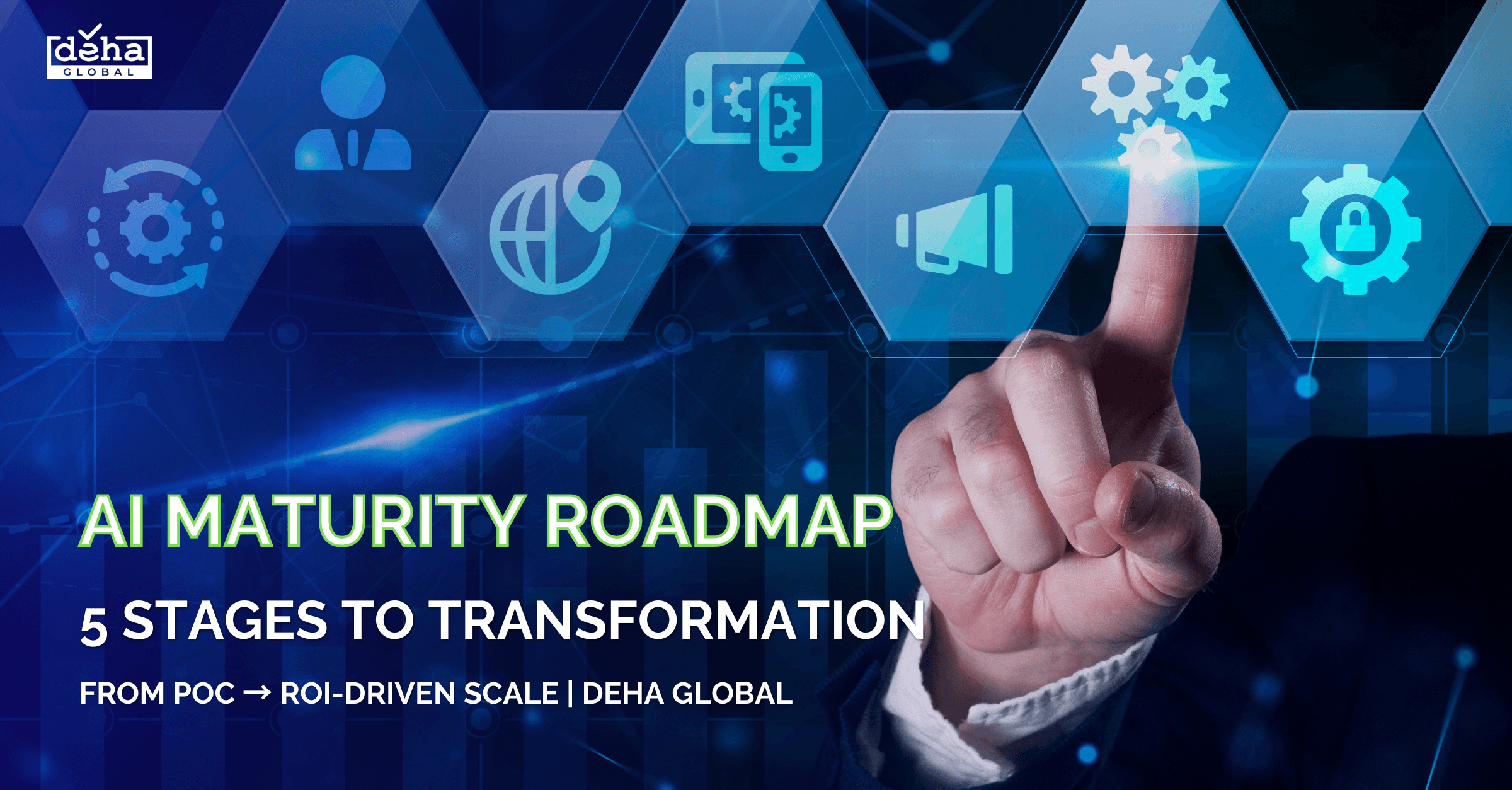Artificial Intelligence (AI) has become one of the most powerful drivers of digital transformation. Enterprises across industries are experimenting with AI for automation, customer engagement, and data-driven decision-making. Yet, despite billions in global investments, many organizations struggle to achieve meaningful ROI.
According to InformationWeek, more than 50% of enterprises remain stuck in the early experimentation stage, with many pilots failing to scale. Without a clear roadmap, AI adoption often results in fragmented projects, unclear business value, and wasted resources.
The solution? Understanding the AI maturity journey—a structured roadmap that helps organizations progress from isolated pilots to enterprise-wide transformation.
Understanding AI Maturity
AI maturity refers to the extent to which an enterprise has integrated AI into its operations, strategy, and value creation models. Organizations with high AI maturity can leverage advanced data pipelines, scalable infrastructure, and robust governance frameworks to consistently extract ROI.
As maturity increases, so do the benefits: faster decision-making, greater innovation capacity, and measurable business growth. Conversely, low maturity levels correlate with siloed experiments, high costs, and unmet expectations.
The 5 Stages of AI Maturity
Stage 1 – Initial (Ad-hoc / Isolated Trials)
- Characteristics: Experiments occur sporadically, often led by enthusiastic teams without executive alignment.
- Risks: No governance, no clear business case, and limited ROI.
- Outcome: AI is seen as “interesting technology” but not yet tied to strategy.
Stage 2 – Experimentation (POCs, Pilots)
- Characteristics: Organizations test AI through proof-of-concepts in one or two functions.
- Risks: The “POC trap”—projects remain stuck in perpetual pilots without scaling.
- KPIs: Cost-saving opportunities, productivity gains, automation efficiency.
- Outcome: Enterprises begin to see potential value but face integration challenges.
Stage 3 – Defined (AI Strategy in Place)
- Characteristics: A formal AI strategy is created, aligned with business objectives. Governance frameworks are introduced.
- Benefits: Clearer ROI measurement, cross-department collaboration.
- Outcome: AI is no longer a series of isolated projects—it becomes a corporate initiative.
Stage 4 – Optimization (AI at Scale)
- Characteristics: AI is deployed across multiple departments with established MLOps pipelines, cloud-native data platforms, and strong governance.
- KPIs: Customer satisfaction (CSAT), revenue growth from AI-enabled services, reduced decision latency.
- Outcome: AI becomes a trusted driver of operational efficiency and customer value.
Stage 5 – Transformation (Enterprise-wide AI)
- Characteristics: AI becomes embedded in the core business model, influencing product design, strategy, and competitive advantage.
- Benefits: Continuous innovation, global competitiveness, and sustainable growth.
- Examples: Microsoft’s Copilot Studio enabling enterprise-wide AI agents; OpenAI’s work on multi-agent systems reshaping automation.
- Outcome: AI transforms from a tool into a strategic partner.
Common Barriers on the Journey
Despite clear benefits, many enterprises face barriers:
- Fragmented Data: Without robust governance, data silos undermine scaling.
- Unclear Objectives: Pilots without measurable KPIs often fail to justify ROI.
- Integration Challenges: Legacy systems resist AI workflows.
- Skills Gap: Lack of collaboration between IT, business, and data teams.
According to Deloitte’s Tech Trends 2025, AI governance and compliance are now board-level priorities, making it critical to embed compliance into IT operations from the start.
How DEHA GLOBAL Supports Enterprises Through the 5 Stages
At DEHA GLOBAL, we help enterprises avoid the “POC trap” by guiding them through a structured POC → MVP → Scale framework:
AI & GenAI Services
- Enterprise AI consulting and strategy design.
- AI model fine-tuning and governance frameworks.
- Internal AI enablement for long-term adoption.
Cloud Services
- Migration to secure, scalable AI-native cloud environments.
- Managed cloud services with 24/7 monitoring and optimization.
DevOps & Cybersecurity
- Migration to secure, scalable AI-native cloud environments.
- Managed cloud services with 24/7 monitoring and optimization.
Case Examples:
- Healthcare: AI assistants supporting doctors with diagnostics.
- Commodities Trading: Data analytics to optimize decision-making.
- Enterprise IT: Cloud migration to support AI-enabled operations.
AI maturity is not a destination—it is a journey. Enterprises that progress beyond experimentation and embed AI across their value chain gain not only ROI but also long-term resilience and competitiveness.
At DEHA GLOBAL, we are more than a service provider—we are a global AI & Cloud partner, helping enterprises move confidently from early adoption to full transformation.
Contact DEHA GLOBAL today to assess your AI maturity and build a roadmap toward ROI-driven, enterprise-wide AI adoption.
